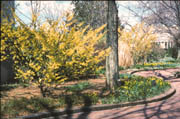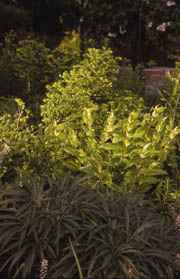A Four-Season
Landscape
By Janet Draper
Now, just a minute
before you go off on a frantic buying spree at the nurseries picking
up everything in bloom like a crazed maniac. (We've all been there---no
use denying it.) Think back to those dreary days of winter and
remember what your garden looked like. Was it totally devoid of
life and the only thing colorful was your neighbor's blue tarp?
If you dream of having a garden full of interesting shapes and
color and maybe even something blooming year 'round, now is the
time to start creating it. Having a colorful spring garden is
relatively easy, but creating a four-season garden takes some
thought.
 Start with making an honest assessment of the conditions you have.
Dreaming of a colorful English border when you have a deeply-shaded
yard full of maple roots is just that, a dream, never to be reality,
only a source of immense frustration.
Start with making an honest assessment of the conditions you have.
Dreaming of a colorful English border when you have a deeply-shaded
yard full of maple roots is just that, a dream, never to be reality,
only a source of immense frustration.
Note how much light an area gets---and not only for one season,
but throughout the year. Define areas that might need some screening.
Neighbors are great, but we all need our privacy. Perhaps one
properly placed evergreen tree might mean the difference between
loving and hating your neighbor.
Once you know what conditions you really have, you can look for
plants that are appropriate for your site. How do you know what
is appropriate? There are numerous ways to learn about plants.
You can use your winters snuggled up with some great gardening
books or, this spring, you can get to know your local nurserymen
and pick their brains.
 Another
way to learn is by attending gardening lectures, which have the
additional benefit of putting you in contact with your fellow
gardeners. Gardeners are generous people not only known for sharing
their knowledge but also for sharing their extra plants. Another
way to learn is by attending gardening lectures, which have the
additional benefit of putting you in contact with your fellow
gardeners. Gardeners are generous people not only known for sharing
their knowledge but also for sharing their extra plants.
My favorite method of learning is to get out and see the plants
themselves. Places like the National Arboretum or London Town
House and Gardens provide wonderful opportunities to see and learn
about plants. All you have to do is stroll through the collections
jotting down the names of the ones you like that are growing in
situations similar to yours. Be sure to visit at various times
throughout the year; something might look ho-hum during one season
but be a show-stopper during others.
During the winter, you tend to notice more details of your plants,
marveling at things that, during
the hurly-burly of summer, you wouldn't even notice. Winter makes
us slow down and be more introspective, noticing the remaining
seed pods on a tree or the wonderful textures of bark or stems.
Instead of scrupulously cutting everything back to the ground
in the fall, try to leave certain plants standing through the
winter to give more interest. Things like ornamental grasses and
the tawny flower heads of hydrangeas are absolutely beautiful
when capped with snow. It doesn't matter that they're not evergreen---they
give wonderful definition and movement in the winter.
Lovely in all four seasons, witchhazels are one of my favorite
winter delights. Every year you can look forward to the bright
yellow spidery flowers of Hamamelis x 'Arnold Promise.' On sunny
days in February or March, when there may still be snow on the
ground, the flowers unfurl their petals like little banners and
emit the sweet lily of the valley fragrance which perfumes the
entire garden. Heaven!
Another plant group that I would not garden without is the Carex
family. Far from being flashy and scene-stealing, this family
has some durable plants that look great during all four seasons.
Carex morrowii 'Variegata' was one of the first I became acquainted
with. It forms clumps with thin dark green linear foliage edged
with a faint white line. Looking like a little hedgehog, the foliage
radiates out from the middle and then gracefully swirls around
itself. The fine texture looks wonderful with just about anything
that you can think of. However, don't stop there---explore the
family more. For even finer texture, there is Carex temnolepsis
or, for more color, C. oshimensis 'Evergold' with its beautiful
tawny yellow and green variegation. And these are just the beginning.
Another of my "must-have" plants for its year-'round contribution
is Helleborus foetidus. Unfortunately it has been burdened with
the horrible common name of Stinking Hellebore---sad, since the
fragrance really isn't that bad. I prefer the common name of Bear's
Foot Hellebore, which describes the elongated hand-like dark evergreen
foliage. The flower stalk is formed in the autumn and teases you
with anticipation until the chartreuse little bell flowers finally
open in late winter. When left on the plant, these floral stalks
will look good for three months or more.
These are just a few of the numerous possibilities that can liven
up your garden. There are so many wonderful plants that there
is really no excuse for not having a garden that makes you happy
year 'round. It might take a little effort to learn about these
special gems, but I guarantee the results will be worth it.
The Annapolis Horticulture Society has free lectures the first
Wednesday of the month at 7 p.m. in St. Anne's Parish Hall. For
more information, call 410-263-0646
 Janet
Draper is a horticulturist and works at the Smithsonian
Institution's Ripley Garden. She is president of the Annapolis
Horticultural Society. Janet
Draper is a horticulturist and works at the Smithsonian
Institution's Ripley Garden. She is president of the Annapolis
Horticultural Society.
|
Back
|

